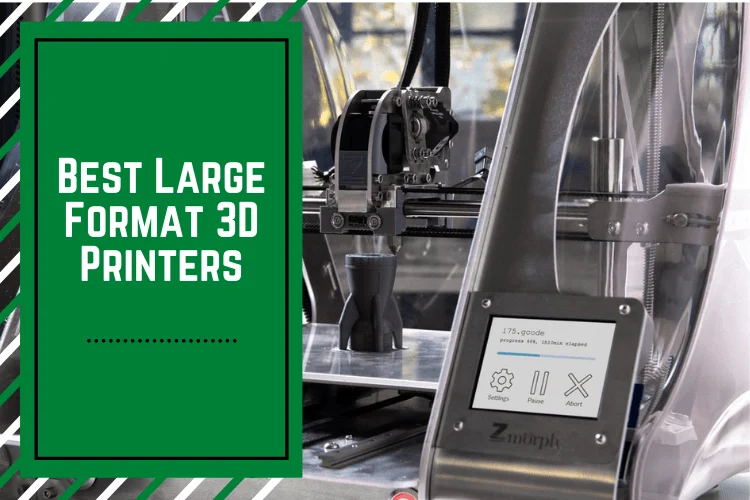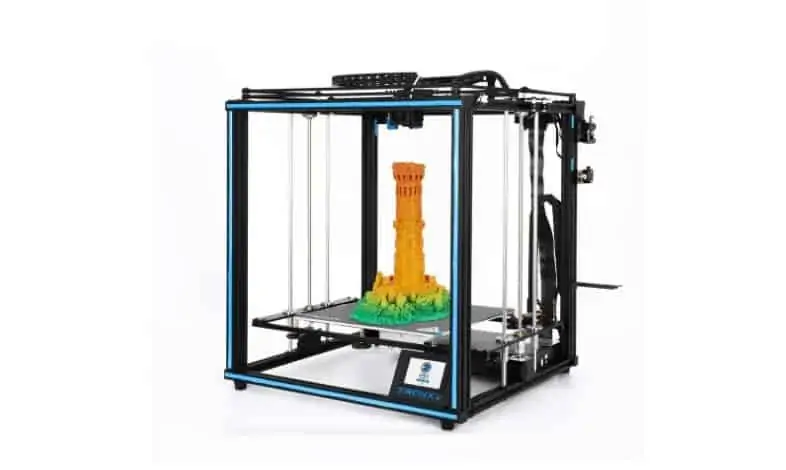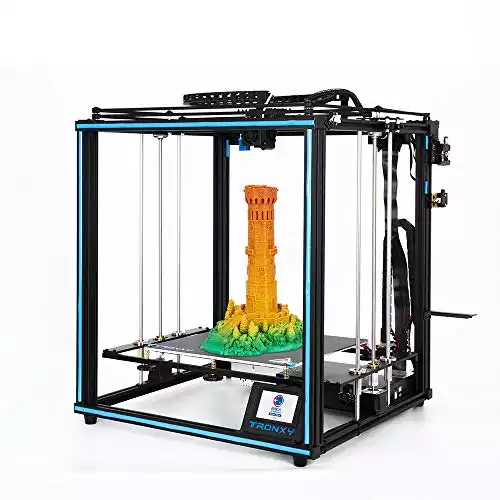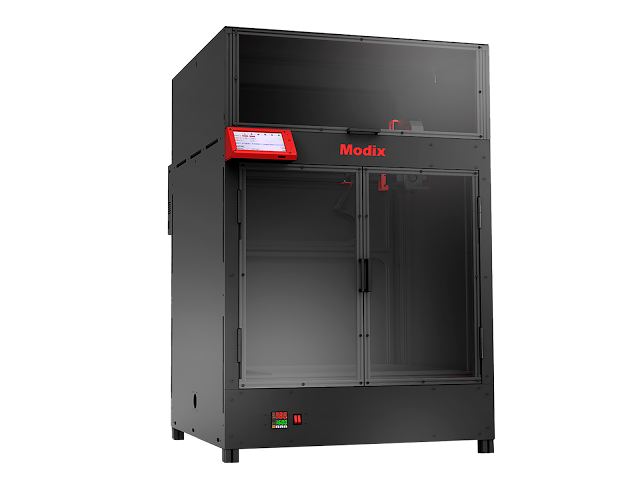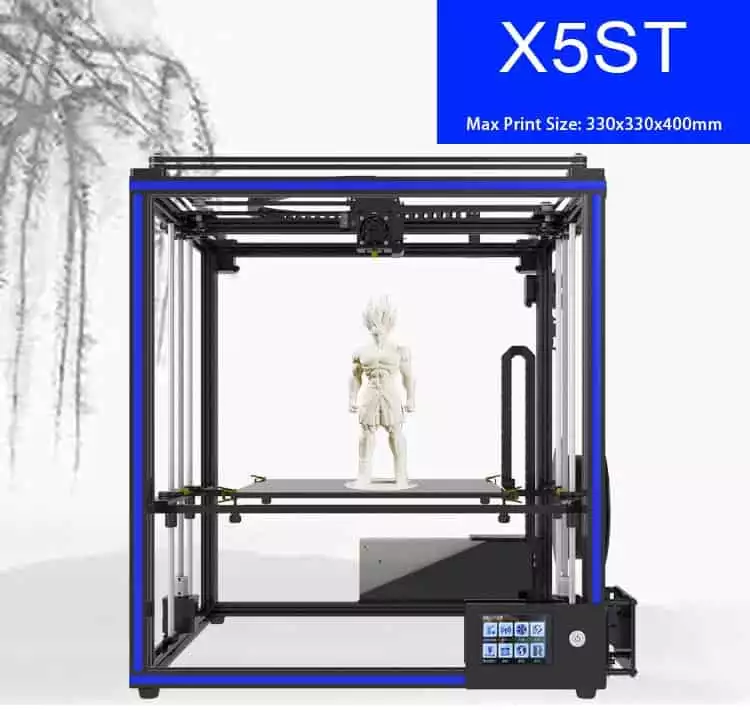- Intamsys FunMat HT Review: Will This Work for You? - June 2, 2022
- BCN3D Epsilon W50 Review: Worth the Price? - June 2, 2022
- Craftbot Flow Review – Is This 3D Printer Worth the Money? - April 23, 2022
3D printers come in a variety of different shapes and sizes, and today we’re going to let you know about the best large format 3D printers that are currently on the market.
These types of printers have become very popular with small businesses as well as some home users. Not only can they print off bigger than normal objects, but they come with many other great features too.
We’ll go over the things you need to look out for before you make a purchase, and we’ll also show you the seven best you can buy.
First, let’s look at why you might need a 3D printer with a larger build volume.
Table of Contents
Up Front Best Large Format 3D Printers
- Tronxy X5SA: Best High-Quality Prints
- FLSUN QQ-S: Best Overall
- Craftbot Flow XL: Best High End
- Creality CR-10 V2: Best High Quality
- gCreate gMax 2: Most Affordable
- Modix Big-60 V3: Aesthetically Pleasing
- Tronxy X5ST-500: Best for Printing Large Objects
Why use a Large Format 3D Printer?
The main difference between a large format 3D printer and many of the other models you’ll see on the market is the build volume.
As these printers have a larger build volume, it means you can print off bigger objects. This is very useful for businesses, and also many home users will find a larger build volume beneficial.
Using this to print off prototypes and experimental parts for development products can also save money in the long run. Businesses that can do this themselves won’t need to outsource the work, which can get very expensive.
So, really using a large format 3D printer is ideal if you need to print off larger objects and want to cut down on manual work of combining smaller parts down the line.
What to look for in a Large Format 3D Printer?
We’re going to show you the seven best large format 3D printers a little later on, but before we do that, there are a few things you need to consider before you buy one.
Cost
This is important, regardless of what kind of 3D printer you are buying.
3D printers can vary in cost quite considerably, and there are many cheaper models available. In fact, the whole market has become much more accessible in general recently. That being said, you’ll find a lot of expensive 3D printers, especially models that offer a bigger print volume.
Ideally, it would help if you looked at a cost to build volume ratio – the bigger the volume for a low price, but you also need to consider print quality.
Print quality
Something else that you should consider is the overall quality of the prints.
It is all well and good having a larger than normal build volume, but if the prints aren’t coming out to a high standard, then it is essentially useless. Using tests like the #3DBenchy is a common way in which to evaluate 3D printers and the quality of the objects they make.
Ease of use
Similar to print quality, buying a state-of-the-art 3D printer is fine, but if it has a very steep learning curve, you won’t be able to use it to its full potential.
3D printers, in general, have become easier to use. As many are now marketed towards a mass audience, their usability has increased. Most 3D printers these days don’t require you to be an engineer or anything like that, and they can be operated by hobbyists and professionals alike.
Supported materials
The last thing you should consider before you go out and buy a large format 3D printer is what materials it supports.
These 3D printers use a filament to print off objects. Some will support different types of material than others. It is useful to think about this because even though most 3D printers support basic types of filament, you don’t want to buy one only to find out later that it doesn’t support the materials you need.
We’re going to list the filament our top picks for the best large format 3D printer, so you know exactly what they support.
7 Best Large Format 3D Printers
These are the top 7 large format 3D printers you can purchase right now that offer bigger build volumes, high print quality, and much more.
Tronxy X5SA
The Tronxy X5SA offers a large build volume (330 x 330 x 400 mm) combined with high-quality prints. It features a double Z-axis, which helps to add stability during the printing process, and there is also a silicone sleeve and improved fan to ensure a consistent temperature. The stability is also helped by the box design.
The X5SA is also very budget-friendly. You’ll find large format 3D printers that cost a lot more than this but don’t provide the same quality.
It supports a wide number of filaments, and the touchscreen is a nice addition, too, as are the filament run out detectors.
Overall the Tronxy X5SA is a very good print with a large build volume and a range of extra features.
Continue reading our full Tronxy X5SA review.
This is a Core XY structure design with full belt transmission, higher stability and printing precision, guarantee the quality of the model; Dual Z-axis design, increase the load capacity of the hot bed, reduce errors in printing, and print more finely.
Pros
- Offers a large build volume combined with a low price
- High print quality and stability during the printing process
- Supports a wide range of different materials
- Filament run out detectors and touchscreen
Cons
- Not recommended for beginners due to the assembly process
Printer specifications
- Build volume: 330 x 330 x 400 mm
- Enclosure: Open
- Filament diameter: 1.75mm
- Materials supported: PLA, ABS, HIPS, PC, PVC
- Connectivity: USB, TF-Card
- Print speed: 100 mm/s
FLSUN QQ-S
The FLSUN QQ-S is definitely a to consider. Even though the is a bit smaller than the , it comes with a host of extra features.
This includes WiFi control, which you often don’t see on many budget 3D printers. That’s another thing, and it is very affordable as well. Given that it supports a wide range of materials and also comes more or less preassembled (around 90% complete), it is ideal for beginners as well.
There are a few teething problems with the FLSUN QQ-S that, if you are new to 3D printing, can take a while to figure out. This includes getting the auto leveling correct as well as some filament dribbling.
That being said, it is a very good and affordable printer for making larger objects.
Flsun QQ-S 3d printer use high quality metal meterial, more stable, get better printing precision.
Pros
- Comes more or less preassembled with little work to do
- Prints high quality objects
- Supports many materials
- Has WiFi connectivity
Cons
- Some printing issues that may be hard for beginners to sort out
- Smaller build volume than the Tronxy X5SA
Printer specifications
- Build volume: 260 x 260 x 320 mm
- Enclosure: Open
- Filament diameter: 1.75mm
- Materials supported: PLA, ABS, flexible, HIPS, Wood, PVA
- Connectivity: USB, SD Card, WiFi
- Print speed: 30 – 300 mm/s
Craftbot Flow XL
More expensive than the other large 3D printers on our list, the Craftbot Flow XL benefits from being a true out of the box machine.
If you are looking for a real ‘plug and play’ 3D printer, this is it. The printer has a 300 x 200 x 500 mm build volume and can support a range of filaments such as PLA, ABS, Exotics. Like the FLSUN QQ-S, it also has WiFi connectivity.
With linear rails and improved bearings, there isn’t a whole lot of noise that comes out of this 3D printer, either. The print quality is really good (as you’d expect for a printer in its price range), and while it might be out of some peoples’ budget, it is a great machine for printing large scale objects.
Check out our complete CraftBot Flow Review.
Even with larger structures, due to the larger build volumes, CraftUnique has ensured a powerhouse of a 3D printer you can always count on.
Pros
- ‘Plug and play’ with little setup required
- Low noise and produces high quality prints
- Has WiFi connectivity
- Large build volume
Cons
- Is a bit on the pricey side compared to other printers
Printer specifications
- Build volume: 300 x 200 x 500 mm
- Enclosure: Open
- Filament diameter: 1.75mm
- Materials supported: PLA, ABS, Exotics
- Connectivity: USB, WiFi
- Print speed: 200 mm/s
Creality CR-10 V2
Moving back into the more affordable range of large format 3D printers and the Creality CR-10 V2 is a high quality 3D printer with a decent build volume of 300 x 300 x 400mm.
It also features an upgraded motherboard, which cuts down on its noise while you will also find dual cooling fans and a filament monitor. It is actually quite straightforward to put together as well, even if you are a beginner. While it does require some assembly, it is easier than other 3D printers.
The Creality CR-10 V2 provides really good quality prints (albeit with a slightly slower printing speed), and for the price, it really has everything you need.
CR-10 V2 stands out as an excellent choice for the beginning hobbyist. You can have the joy of a printer in a one-step assembly and three-step connection.
Pros
- Doesn’t make a lot of noise due to the recent motherboard upgrade
- Has a handy filament monitor
- Large build volume and easy to assembly
- Low cost, so it’s in the affordable category for most people
Cons
- Printing speed can be quite slow but does produce quality prints
Printer specifications
- Build volume: 300 x 300 x 400mm
- Enclosure: Open
- Filament diameter: 1.75mm
- Materials supported: PLA, ABS, PETG, TPU
- Connectivity: SD Card
- Print speed: 30-60 mm/s
gCreate gMax 2
OK, so the gCreate gMax 2 has a pretty massive build volume of 457 x 457 x 609 mm, but it comes at a cost – literally. It isn’t cheap, and if you are in the market for a budget option – like the Creality CR-10 V2, FLSUN QQ-S, or the Tronxy X5SA – this isn’t the machine for you.
That being said, it does come with a wide range of different features. This includes WiFi connectivity, a BL touch bed leveling sensor, in addition to being able to use a varied range of materials. It has a filament runout sensor, and there isn’t much setup or assembly required either.
There have been several reports of regular thermistor failures with this 3D printer. However, overall it not only has a really big build volume with a ton of great features, but it offers quality prints too.
Pros
- It’s ideal for beginners with very little assembly needed
- Large build volume of 457 x 457 x 609 mm
- WiFi connectivity and BL touch bed leveling sensor
Cons
- Expensive so perhaps out of the price range for many people
- Reports of regular thermistor failures
Printer specifications
- Build volume: 457 x 457 x 609 mm
- Enclosure: Open
- Filament diameter: 1.75mm
- Materials supported: PLA, ABS, PETG, TPU, CF-Nylon, CF-Composites, Polycarbonate, Metal Composites
- Connectivity: WiFi, SD Card, USB
- Print speed: 150 mm/s
Modix Big-60 V3
The Modix Big-60 V3 is getting us back into the pricier side of large 3D printers, but not only does this machine perform very well, and it also looks great too.
If aesthetics are your thing, then the Big-60 V3 is a fantastic look printer. Even though it is on the expensive side on this list, for what you actually get, it isn’t bad at all. The printer has a 600 x 600 x 660 mm build volume, and you can add an enclosure on as well.
With a BLTouch auto leveling sensor, WiFi connectivity, filament runout sensor, and a dual-zone silicon heater, to name but a few, there is a lot going on with this printer. Costly – yes, but it actually represents good value for a top printer.
Continue reading our full Modix Big-60 Review.
Offering a print volume of 600 x 600 x 660 mm (23 x 23 x 25” in) this self-assembly 3D printer kit is the most cost-effective option for achieving your large 3D printing goals.
Pros
- Large build volume and aesthetically pleasing 3D printer
- Has WiFi connectivity alongside USB and SD card options
- BLTouch auto-leveling sensor and dual-zone silicon heater
- Can add on enclosure if you wish
Cons
- Aimed more at professionals rather than for home use
Printer specifications
- Build volume: 600 x 600 x 660 mm
- Enclosure: Open (can add enclosure addon)
- Filament diameter: 1.75mm
- Materials supported: PLA, ABS, Nylon, TPU, HIPS, Exotics
- Connectivity: WiFi, SD Card, USB
- Print speed: 150 mm/s
Tronxy X5ST-500
This is this second Tronxy on our list, and the Tronxy X5ST-500 comes with a large 500 x 500 x 600 mm build volume.
The Z-axis double screws help to add stability to the machine while aids precision and printing accuracy. You can pause and resume prints with this printer while there is a filament run-out detector as well.
It also comes in at the budget end of the scale, which is ideal if you need a large-format 3D printer but doesn’t necessarily have a ton of money to spend. There are some issues with heat management. Not only does it heat up slowly, but it can stop working once it reaches a certain temperature.
While there are potential workarounds for this, if you are a beginner, it isn’t really something you should do. The software needs to be updated to be fully functional as well. Overall, it’s a decent large-format 3D printer that does have some downsides.
Newest Tronxy X5ST 500 3D printer kit 500 x 500 x 600 heat bed big printing size. DIY kits with touch screen filament detector.
Pros
- Has a large build volume for printing big objects
- Low cost so isn’t going to break the bank
- Precision and stability with quality prints
Cons
- Issues around reaching the desired temperatures for print materials beyond PLA
- The software needs to be updated and doesn’t come with a bootloader
Printer specifications
- Build volume: 500 x 500 x 600 mm
- Enclosure: Open
- Filament diameter: 1.75mm
- Materials supported: PLA, ABS, HIPS, WOOD, PVC, NYLON
- Connectivity: TF Card, USB
- Print speed: 100 mm/s
Frequently Asked Questions
If you plan on producing larger than normal prints, then yes. Large-format 3D printers come with a bigger build volume than standard printers so you can print off bigger objects.
Not really. The print quality should be the same; however, it is important to check out reviews to ensure that you aren’t sacrificing build volume for a high-quality print.
They can be. We have tried to combine both budget options and more expensive options on this list. You can find cheap large-format 3D printers as well as pricier models.
In most cases, some assembly is required. Some printers will require a full assembly, which isn’t ideal for beginners, whereas some large-format 3D printers come almost ‘plug and play’, and you only have some basic tasks before you can print.
Yes. While some of the printers on our list aren’t really aimed at beginners due to the assembly required, most of these printers can be used if you are new to 3D printing. You might make a few mistakes at first, but they aren’t overly difficult to operate.
Which is the best large format 3D printer?
Being able to print off large objects with a 3D printer requires a decent size build volume.
To negate having to print off different smaller parts and join them together, later on, printing off a full larger scale model can save both time and money.
All the large format 3D printers we’ve listed here do a very good job at printing off bigger objects, but we need to pick one.
We’re going to choose one in the budget category and go with the FLSUN QQ-S.
Flsun QQ-S 3d printer use high quality metal meterial, more stable, get better printing precision.
It doesn’t have the biggest build volume on our list (260 x 260 x 320 mm) but what it does do is come with a great range of features. For a start, you are getting WiFi connectivity on a 3D printer in a budget price range, which isn’t that common. It also supports a wide range of materials such as PLA, ABS, HIPS, Wood as well as PVA, and you get a quick print speed too.
One thing that sets this apart from many other 3D printers is that there isn’t a lot of assembling to do. OK, there are a few drawbacks with this printer for beginners – such as filament dribbling and some issues around the auto leveling – but they’re solvable with experience.
Overall the FLSUN QQ-S offers a large printing bed and high quality printing for a very affordable price.
This is why it is the best large format 3D printer on this list, and if you don’t mind some tinkering and learning as you go, you should definitely consider this 3D printer for printing bigger objects.

